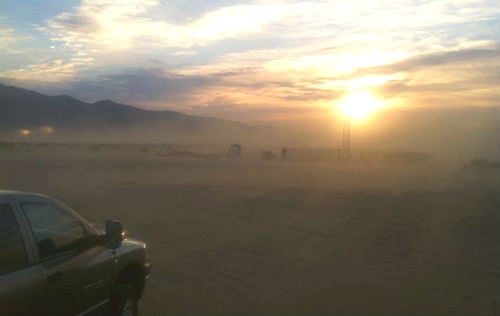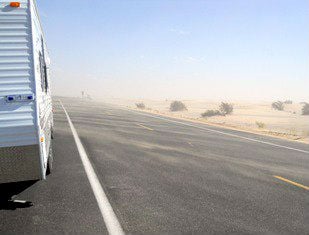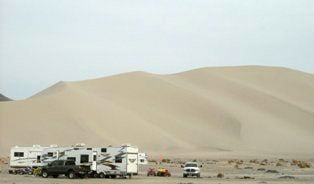Desert dry camping is one of those things that RVers either enjoy or despise. If you’re not sure you want to give it a whirl this snowbird season, these tips might help you decide.

While dry camping in the desert has its benefits, there are trade offs. You can’t do anything about the conditions but you can certainly prepare for it. Photo courtesy of Peterrrr, irv2.com member
Coping with Desert Dry Camping Dust
I’ve gone desert dry camping in many great spots throughout the Southwest. My husband and I enjoy it because desert dry camping is usually:
- Affordable. It’s often free.
- Beautiful. Colorful desert sunsets are unforgettable.
- Calming. You leave city sounds and lights far behind.

California desert boondocking windstorm.
But like life itself, there’s a big trade off to dry camping in Arizona, California and New Mexico, and the great winter snowbird destinations in the southwest: the dust! In fact, as I write this a major windstorm is rocking our fifth wheel. We’re camped near the Salton Sea and a dust cloud is coming toward us. Like it or not, a fine layer of grit will coat everything when this is over. To combat the inevitable filth, here’s how I’ll cope during and after the storm.
You can’t do anything about the weather but you can prepare for it. Also, keeping dust under control during a wind storm is one of the critical dry camping tips new RVers must know (as well as veterans). Here’s what I do when I know we’re in for a doozy.
Activate Anti-Dust Measures
If you’ve ever traveled to the Southwest in March, you know that desert dry camping dust is a way of life during spring. To cope, I follow the simple preventive measures that The Burning Man Festival RVers recommend. First, cover your RV window air vents with painter’s tape. It’s not attractive but it`s effective for keeping out the dust.

All the dust is one of trade-off when desert camping.
Brace for What’s to Come
The deafening roar of constant wind is so irritating. When you live in a RV, wind noise is loud and scary. Since there’s nothing we can do about it anyways, I just brace myself for the oncoming storm and try not to worry.
Begin Wiping Surfaces
When the storm begins, a damp rag is all it takes to start removing dust. It’s a never-ending ordeal during heavy, ongoing winds but it keeps my mind off the storm.
Close Windows
This is easy if you’re hooked up to shore power. You can always run your air conditioner if things get too hot. But desert dry camping when it’s warm is another matter because closing windows can make you sweat. To keep our home cool I darken the living area with heavy day/night RV shades.

Sometimes it’s best to just accept the inevitable of dust in desert conditions.
Cover Floor Vents
We have magnetic strips over the heater vents on our floors. They prevent pet fur from falling into the ducts, and also help to minimize dust in our living area.
Once during a bad desert dust storm while dry camping we were trapped inside for three days. On the fourth morning, the wind was still blowing enough to be a nuisance but not dangerous, so we moved to a less windy camp site.
Like it or not, desert dry camping dust is one of the trade-offs of a more freewheeling lifestyle. Whether you go sun seeking in winter and stay in one place all season, or drive on dusty roads in summer, your things will get dusty, dirty and beat-up. I’ve found that it’s best to just accept the inevitable and focus instead on all of the awesome adventures that await you on perfectly windless days.

I came across some Tyvek RV covers. Uncertain how well they would work during a dust storm. or dusty conditions. I assume they would likely hold heat in, increasing temperatures inside a RV.
However, under certain conditions might help to prevent additional dust from accumulating inside a RV during a dust storm or under dusty conditions.
DuPont TyvekRV fabric on the roof of this Designer Series ADCO cover is engineered to block up to 98 percent of dirt and dust particles larger than 3 microns, and also blocks up to 99.8 percent of the sun’s UV rays.
http://www.cabelas.com/product/CLASSIC-PP-RV-COVER/1908468.uts?productVariantId=3477612&WT.tsrc=PPC&WT.mc_id=GoogleProductAds&WT.z_mc_id1=03668657&rid=20&gclid=CJO9vtDk_tACFYmRfgodZ-oKig&gclsrc=aw.ds
There are many online stores that sell these covers. Here’s a website that sells Custom Tyvek RV cover by the foot.
http://www.rvcovers.com/products/custom-travel-trailer-cover
Perhaps other have experiences using this type of RV cover? Any good during a dust storm or dusty conditions? Increases temperature too much inside a RV?
Traveling in a trailer is one of the most convenient ways to camping, hunt and travel. I bought rv cover for my trailer to protect it from the elements.
In addition to closing the windows and vents cover your trailer hitch
We spent hours cleaning the dust and dirt out of the hitch this was done to be able to once again move the latch
I have a Forest River Sportscoach 339DS Class A Diesel pusher.
For those that have any RV with two or more AC units and common in roof ducting there is another explination for excessive dust in the RV.
You can test for common ducting by running only one AC unit. If cool air comes out of all cieling vents then you have common ducting.
If you then place your hand under the air filter on the AC unit that’s off, and you feel cool air coming down through the air filter this might explain where the dust is coming from as whatever dust had collected on the air filter will dislodge and fall into the living space.
Why don’t the RV manufacturers provide a one-way baffle to prevent air from flowing backwards past the AC’s squirrel cage blower when it’s not running?